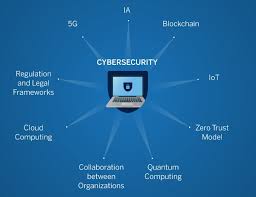Cybersecurity Trends: Emerging Threats and Solutions

SEO Meta Description:
Stay informed about the latest cybersecurity trends, emerging threats, and innovative solutions. Discover expert insights on mitigating risks and safeguarding your digital assets.
Introduction:
In today’s interconnected digital world, cybersecurity is paramount. As technology advances, so do the threats posed by cybercriminals. This article delves into the evolving landscape of cybersecurity, highlighting emerging threats and innovative solutions to mitigate risks effectively.
Understanding Cybersecurity Trends
In this section, we explore the current landscape of cybersecurity and how it’s evolving to combat emerging threats.
The Rise of Cyber Attacks
Cyber attacks are becoming increasingly sophisticated, targeting individuals, businesses, and governments alike. From ransomware to phishing scams, cybercriminals employ various tactics to exploit vulnerabilities.

Impact on Industries
Cybersecurity threats transcend industry boundaries, impacting sectors such as finance, healthcare, and transportation. Explore how different industries are vulnerable to cyber attacks and their implications.
Emerging Threats
This section delves into the latest cybersecurity threats that organizations need to be aware of to stay ahead of potential breaches.
AI-Powered Attacks
As artificial intelligence (AI) technology advances, so does its potential application in cyber attacks. Learn how AI-powered attacks can bypass traditional security measures and the steps needed to counteract them.
IoT Vulnerabilities
The Internet of Things (IoT) introduces a myriad of cybersecurity challenges due to its interconnected nature. Discover the vulnerabilities associated with IoT devices and strategies to secure them effectively.
Innovative Solutions
To combat evolving cybersecurity threats, organizations must adopt proactive measures and innovative solutions.
Behavioral Analytics
Behavioral analytics leverages machine learning algorithms to detect anomalies in user behavior, enabling early detection of potential security breaches. Explore how organizations are leveraging this technology to bolster their cybersecurity posture.
Zero Trust Framework
The Zero Trust framework adopts a holistic approach to security by assuming that threats may already exist within the network. Learn how this model emphasizes continuous verification and strict access controls to mitigate risks effectively.
Cybersecurity Trends: Emerging Threats and Solutions
In this pivotal section, we delve deeper into the key trends shaping the cybersecurity landscape and the corresponding solutions.

Cloud Security
With the widespread adoption of cloud computing, ensuring robust cloud security measures is imperative. Discover the latest trends in cloud security and best practices for safeguarding cloud-based assets.
Endpoint Protection
Endpoints represent vulnerable entry points for cyber attacks. Learn about emerging threats targeting endpoints and innovative solutions such as endpoint detection and response (EDR) to bolster security.
FAQs
Here are some frequently asked questions about cybersecurity trends and solutions:
- What are the common types of cyber attacks?
- Common cyber attacks include malware, phishing, ransomware, and DDoS attacks.
- How can organizations enhance their cybersecurity posture?
- Organizations can enhance their cybersecurity posture by implementing robust security measures such as multi-factor authentication, encryption, and regular security audits.
- What role does employee training play in cybersecurity?
- Employee training is crucial in raising awareness about cybersecurity best practices and identifying potential security threats.
- How does the Zero Trust framework differ from traditional security models?
- Unlike traditional security models that trust users and devices within the network perimeter, the Zero Trust framework adopts a “never trust, always verify” approach, requiring continuous authentication and authorization.
- What are the benefits of behavioral analytics in cybersecurity?
- Behavioral analytics can help detect abnormal user behavior indicative of a security threat, enabling organizations to respond promptly and mitigate risks effectively.
- How can small businesses strengthen their cybersecurity defenses?
- Small businesses can strengthen their cybersecurity defenses by implementing basic security measures such as firewall protection, regular software updates, and employee training on cybersecurity best practices.
Conclusion
As cybersecurity threats continue to evolve, staying informed about emerging trends and adopting proactive security measures is essential. By leveraging innovative solutions and adopting a proactive mindset, organizations can effectively mitigate risks and safeguard their digital assets.
